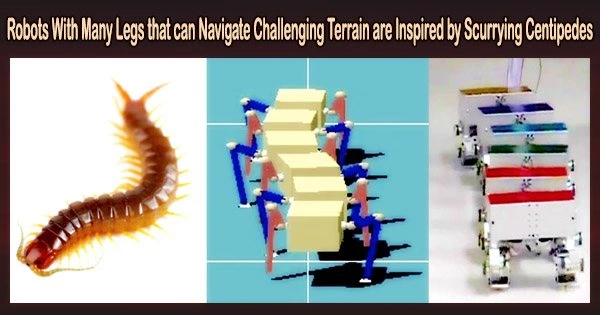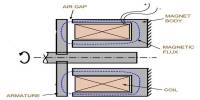Centipedes are elongated arthropods belonging to the class Chilopoda. They are known for their wiggly walk. With tens to hundreds of legs, they can traverse any terrain without stopping. The number of legs varies depending on the species, ranging from around 30 to over 300 legs.
“When you see a scurrying centipede, you’re basically seeing an animal that inhabits a world that is very different than our world of movement,” said Daniel Goldman, the Dunn Family Professor in the School of Physics. “Our movement is largely dominated by inertia. If I swing my leg, I land on my foot and I move forward. But in the world of centipedes, if they stop wiggling their body parts and limbs, they basically stop moving instantly.”
A group of physicists, engineers, and mathematicians at the Georgia Institute of Technology are taking advantage of this type of movement to explore if the multiple limbs could be useful for locomotion in this environment. They produced many-legged robotic models and devised a new theory of multilegged locomotion. They found that, as the theory anticipated, the redundant-leg robot could navigate across uneven surfaces without the use of any additional sensing or control technologies.
These robots have the potential to be used for agriculture, space exploration, and even search and rescue because they can traverse through difficult terrain.
The researchers presented their work in the papers, “Multilegged Matter Transport: A Framework for Locomotion on Noisy Landscapes,” in Science in May and “Self-Propulsion via Slipping: Frictional Swimming in Multilegged Locomotors,” in Proceedings of the National Academy of Sciences in March.
A Leg Up
To better understand why a multilegged robot was so successful at movement, the researchers for the Science publication were inspired by mathematician Claude Shannon’s communication theory, which illustrates how to reliably transfer messages over distance.
According to the theory of communication, one technique to make sure a message travels from point A to point B on a busy line is to split it up into discrete digital units and repeat these units with the proper coding rather than sending it as an analog signal.
It’s truly impressive to witness the multilegged robot’s proficiency in navigating both lab-based terrains and outdoor environments. While bipedal and quadrupedal robots heavily rely on sensors to traverse complex terrain, our multilegged robot utilizes leg redundancy and can accomplish similar tasks with open-loop control.
Juntao He
“We were inspired by this theory, and we tried to see if redundancy could be helpful in matter transportation,” said Baxi Chong, a physics postdoctoral researcher. “So, we started this project to see what would happen if we had more legs on the robot: four, six, eight legs, and even 16 legs.”
A team led by Chong, including School of Mathematics postdoctoral fellow Daniel Irvine and Professor Greg Blekherman, developed a theory that proposes that adding leg pairs to the robot increases its ability to move robustly over challenging surfaces a concept they call spatial redundancy.
Due of this redundancy, the robot’s legs can function well without the aid of sensors to understand their surroundings. The large number of legs ensures that it continues to move even if one leg fails.
In essence, the robot transforms into a dependable system to get from point A to point B across challenging or “noisy” terrain. The idea is similar to how on wheels, if the track or rail is smooth enough, punctuality may be guaranteed without having to engineer the environment to achieve this punctuality.
“With an advanced bipedal robot, many sensors are typically required to control it in real time,” Chong said. “But in applications such as search and rescue, exploring Mars, or even micro robots, there is a need to drive a robot with limited sensing. There are many reasons for such sensor-free initiative. The sensors can be expensive and fragile, or the environments can change so fast that it doesn’t allow enough sensor-controller response time.”
To test this, Juntao He, a Ph.D. student in robotics, conducted a series of experiments where he and Daniel Soto, a master’s student in the George W. Woodruff School of Mechanical Engineering, built terrains to mimic an inconsistent natural environment. He then tested the robot by increasing its number of legs by two each time, starting with six and eventually expanding to 16.
The hypothesis anticipated that as the number of legs rose, the robot would be more nimble in navigating the terrain, even without sensors (PGR1). The robot was eventually tested outdoors on actual ground, demonstrating its ability to move through a range of conditions.
“It’s truly impressive to witness the multilegged robot’s proficiency in navigating both lab-based terrains and outdoor environments,” Juntao said. “While bipedal and quadrupedal robots heavily rely on sensors to traverse complex terrain, our multilegged robot utilizes leg redundancy and can accomplish similar tasks with open-loop control.”
Next Steps
The researchers are already applying their discoveries to farming. In order to deploy these robots to weed farms where weedkillers are useless, Goldman co-founded a business.
“They’re kind of like a Roomba but outside for complex ground,” Goldman said. “A Roomba works because it has wheels that function well on flat ground. Until the development of our framework, we couldn’t confidently predict locomotor reliability on bumpy, rocky, debris-ridden terrain. We now have the beginnings of such a scheme, which could be used to ensure that our robots traverse a crop field in a certain amount of time.”
The researchers also want to refine the robot. They are figuring out the ideal number of legs to achieve motion without sensing in a way that is economical but yet achieves the advantages now that they understand why the centipede robot structure works.
“In this paper, we asked, ‘How do you predict the minimum number of legs to achieve such tasks?’” Chong said. “Currently we only prove that the minimum number exists, but we don’t know that exact number of legs needed. Further, we need to better understand the tradeoff between energy, speed, power, and robustness in such a complex system.”
















